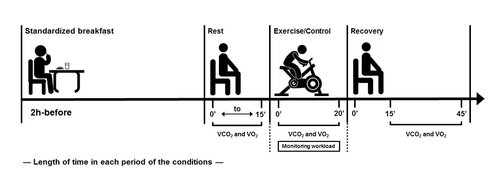-
Home
-
About JCTR
-
Gold Open Access
-
Issues
-
Editorial board
-
Author guidelines
-
Publication fees
-
Online first
-
Special issues
-
News
-
Publication ethics
-
Partners
-
Submit your manuscript
-
Submit your review report
-
Editorial Office
-

This work is licensed under a Creative Commons Attribution-NonCommercial 4.0 International License. ISSN print: 2382-6533 ISSN online: 2424-810X
Volume 2 Issue 2
High-intensity, but not moderate-intensity, exercise increases post-exercise rate of fat oxidation in type 2 diabetics
Ricardo Y. Asano, Marcelo M. Sales, Rodrigo A. V. Browne, José F. V. N. de Moraes, Rafael da Costa Sotero, Gisela Arsa, Jonato Prestes, Johanna Lopez, John E. Lewis, Herbert G. Simões
Asano et al., J Clin Transl Res, 2016; 2(2): 55-62
Published online: 21 May, 2016
Abstract
Background: Aerobic exercise is recommended for glycemic and weight control in type 2 diabetes (T2D), but exercise intensity that increase post-exercise fat oxidation has not been established yet. It is expected that high-intensity exercise induce higher absolute oxidations and rates of oxidation of CHO (during) and fat (after) in normoglycemic, but in hyperglycemic it is unclear.
Aim: To compare the effects of exercise intensity on CHO and fat oxidation during and after exercise in individuals with T2D.
Methods: Eleven persons with T2D, randomly underwent three experimental sessions 72 hours apart: 1) 20 minute of high-intensity exercise (120% of lactate threshold (LT) – 120%LT), 2) 20 minute of moderate-intensity exercise (80% of LT – 80%LT), and 3) 20 minute of control session (CON) – no exercise was performed and the individuals remained seated during the whole time. Percentages of CHO and fat contribution and CHO and fat oxidation rate (mg∙min-1) were analyzed during and after sessions.
Results: The rate of CHO oxidation during exercise was significantly higher during 120%LT in relation to 80%LT and CON (18.2±5.6 vs. 9.5±2.7 vs. 1.1±0.4 mg∙min-1), the absolute rate of fat oxidation was significantly higher in 120%LT compared to 80%LT and CON during exercise (13.5±3.3, 9.5±2.2, and 0.7±0.2 mg∙min-1, respectively, p<0.05). During the post-exercise oxygen consumption recovery period, only the 120%LT had higher fat oxidation (94.5% vs. 68.1%; p<0.05), when compared to CON. Both exercise sessions equally elicited a lowered glycaemia during the post-exercise period, but CHO oxidation was lower after 120%LT than CON (0.1±0.2 vs. 0.9±0.5 mg∙min-1, p<0.05).
Conclusions: Higher intensity elicited an elevated CHO oxidation rate during exercise and a higher percentage of fat utilization during the post-exercise recovery period compared to moderate-intensity exercise and control sessions.
Relevance for patients: High-intensity aerobic exercise, even of short duration, may benefit individuals with T2D on the substrate oxidation related to the body fat. Exercise can be an important tool for the prevention and management of T2D due to its effects on carbohydrate and fat metabolism, reduction of body fat, and control of blood glucose.

DOI: http://dx.doi.org/10.18053/jctres.02.201602.003
Author affiliation
1 Municipal Foundation of Higher Education of Bragança Paulista, Bragança Paulista, São Paulo, Brazil
2 Mogi das Cruzes University, Mogi das Cruzes, São Paulo, Brazil
3 Catholic University of Brasília, Brasília, Distrito Federal, Brazil
4 School of Health, UDF – University Center, Brasília, Brazil
5 Federal University of Rio Grande do Norte, Natal, Rio Grande do Norte, Brazil
6 Federal University of Vale do São Francisco, Petrolina, Pernambuco, Brazil
7 Federal University of Mato Grosso, Cuiabá, Mato Grosso, Brazil
8 University of Miami Miller School of Medicine, Miami FL, USA
*Corresponding author:
Ricardo Yukio Asano
Fundação Municipal de Ensino Superior de Bragança Paulista
Av. Francisco Samuel Lucchesi Filho, 770 – Penha
Bragança Paulista 12929-600, SP, Brazil
Tel: +55 (11) 4035-7800 / + 55 (11) 97011-5500
E-mail: ricardoasano1@gmail.com
Handling editor:
Rowan van Golen
Department of Experimental Surgery, Academic Medical Center, University of Amsterdam, the Netherlands

